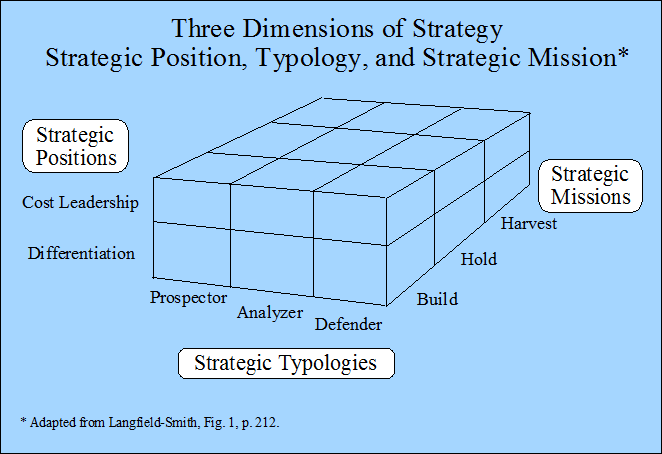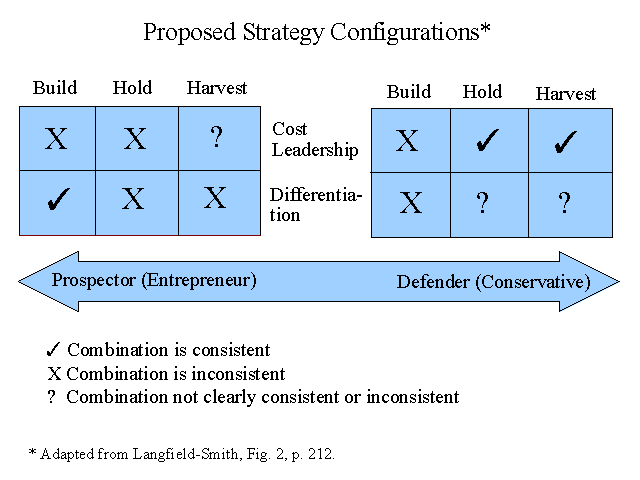
Summary by James R. Martin, Ph.D., CMA
Professor Emeritus, University of South Florida
Controllership & Control Main Page | Strategy
Related Main Page | Theories Main Page
The purpose of this article is to review and critique the stream of research related to management control systems and strategy. The paper is separated into five sections as follows:
1. Management Control Systems
2. Strategic Frameworks
3. Analysis of Research Evidence - Contingency Research, Case Study Research, and Contemporary approaches to performance measurement systems
4. Methodological Limitations of Contingency Studies
5. Conclusions and Directions for Future Research
Management Control Systems
Although Anthony defined management control as separate from strategic control and operational control1, the author argues that this is an artificial separation that may no longer be useful in an environment where employee empowerment has become popular. In addition, various categories of control are discussed including formal and informal controls; output and behavior controls; market, bureaucracy and clan controls; administrative and social controls; and results, action and personnel controls.
Strategic Frameworks
This section includes a number of subsections related to defining strategy (e.g., the type of business to operate, how to structure and finance the company, how to convert competences into competitive advantage, etc.); the formulation and implementation of strategy (intended strategy versus realized strategy); alternative research paradigms (i.e., strategy as an outcome of rational choice, as a craft, or as a ritual); how to operationalize strategy (textual description, partial measurement, multidimensional measurement, and typologies); strategic variables (organizational types - defenders, prospectors, and analyzers); Porter's generic strategies (i.e., cost leadership, differentiation, and focus); conservative (reluctant innovators) versus entrepreneurial firms (aggressive innovators); and strategic missions (i.e., build, harvest, hold, and divest). This rather confusing assortment of terms is made more comprehensible in the graphic below where the various combinations of the dimensions of strategy are indicated as a matrix of choices.

An adaptation of the author's proposed configurations of strategy appears in the graphic illustration below where the checks indicate consistent combinations, the Xs show inconsistent combinations, and the question marks indicate choices that are unclear.

Prospector firms will tend to use a differentiation and build strategy. Defenders, on the other hand, will tend to use a cost leadership and hold or harvest strategy.
Analysis of Research Evidence
Contingency Research
This section includes a discussion of nine studies that used contingency theory to examine the relationship between MCS and strategy. Each study is listed in Table 1 (not included here) indicating the method used, sample, control variables, how strategy was defined, dependent variables, independent variables, and sources of measures (pp. 214-216).
The studies that examined the nature of control systems and strategy support the proposed organizational and control characteristics above, i.e., the combinations of defender & cost leadership; and prospector & differentiator.
Studies that examined the relationship between control systems and the level of competition indicated that the more intense the competition, the more reliance placed on formal control. The types of specific controls used was unclear.
Other contingency studies indicated some agreement among researchers that cost control fits firms that follow a defender strategy, but there were some conflicting results. For example, Simons found that prospectors placed emphasis on controls.
Contingency studies related to performance evaluation and reward systems indicate that objective performance evaluation and rewards support defender strategies, while subjective evaluation is more appropriate for differentiators. But there are several unanswered questions in this area such as the appropriate mix of salary and non-salary components of rewards.
Other sub-sections include short discussions of resource sharing and control systems; and operational control systems and strategy. For example, Ouchi's socialization or clan controls are mentioned as potentially appropriate in cases where a prospector strategy is used.
Case Study Research
One case related to managers' perceptions (Archer and Otley, 1991) indicated that a mix of formal and informal controls can be used to support a strategy, committee meetings were used to link control and strategy, and the managers' perceptions may mediate the potential for the control system to support strategy. Roberts (1990) study found that accounting controls can inhibit the successful formulation and implementation of strategy, while Knight and Willmott (1993) found that accounting control systems were used to cause change in an insurance company.
Simons' various studies (1987, 1990, 1991, and 1994) were used to develop the levers of control involving what Simons refers to as interactive and diagnostic controls.2 Simons presented three propositions including: managers with a clear sense of strategic vision may choose one type of control system to use interactively (i.e., personal involvement and intimacy with the issues), senior managers use multiple control systems interactively only during periods of crisis, and senior managers without strategic vision do not use control systems interactively. Simons' four constructs including belief systems, interactive systems, boundary systems and diagnostic systems are also mentioned in this section.
Overall, these case studies provide little indication of which types of controls fit particular strategies, but, according to the author, they do provide valuable insights related to the formulation and implementation of strategies.
Contemporary Approaches to Performance Measurement Systems
This is a short section that includes mention of papers in professional journals such as Harvard Business Review, Management Accounting, and Journal of Cost Management. Kaplan and Norton's articles related to the balanced scorecard are briefly mentioned as examples of professional papers that relate to strategy implementation.
Methodological Limitations of Contingency Studies
Some of the limitations discussed include the following. The distinction between the existence and use of controls was not recognized in many of the studies. Many studies omitted a wider range of controls including clan controls. Many studies assumed that financial performance is equivalent to effectiveness, while others used innovation to measure effectiveness, although these aspects of performance are not always appropriate.
Although strategy can be measured with several variables, few studies recognized strategy's multi-dimensional nature. Some studies used certain types of strategy variables that resulted in a circular research design. Other researchers failed to recognize the distinction between intended and realized strategy, while others ignored the relative nature of strategy. In addition, the typologies used by researchers (e.g., prospector vs. defender) may not be relevant to the managers surveyed and managers might not be fully aware of their organization's strategy. Finally, the studies failed to recognize that strategy is a continuous process.
Conclusions and Directions for Future Research
This review reveals that the relationships between management control systems and strategy are complex and that prior research has left many unanswered questions related to the role MCS can play in formulating, implementing and minimizing the disruption generated by strategic change.
________________________________________________
Notes:
1 Anthony, R. N. 1964. Framework for analysis. Management Services (March-April): 18-24. (Summary).
2 Martin, J. R. Not dated. Simon's levers or control in relation to the balanced scorecard. Management And Accounting Web. Simon'sLeversofControl.htm
Other related Summaries:
Chenhall, R. H. 2003. Management control system design within its organizational context: Findings from contingency-based research and directions for the future. Accounting, Organizations and Society 28(2-3): 127-168. (Summary).
Chenhall, R. H. and K. Langfield-Smith. 1998. The relationship between strategic priorities, management techniques and management accounting: An empirical investigation using a systems approach. Accounting, Organizations and Society 23(3): 243-264. (Summary).
Covaleski, M. and M. Aiken. 1986. Accounting theories of organizations: Some preliminary considerations. Accounting, Organizations and Society 11(4-5): 297-319. (Summary).
Covaleski, M. A., M. W. Dirsmith and S. Samuel. 1996. Managerial accounting research: The contributions of organizational and sociological theories. Journal of Management Accounting Research (8): 1-35. (Summary).
Ferreira, A. and D. Otley. 2009. The design and use of performance management systems: An extended framework for analysis. Management Accounting Research (December): 263-282. (Summary).
Fonvielle, W. and L. P. Carr. 2001. Gaining strategic alignment: Making scorecards work. Management Accounting Quarterly (Fall): 4-14. (Summary).
Fullerton, R. R. and C. S. McWatters. 2002. The role of performance measures and incentive systems in relation to the degree of JIT implementation. Accounting, Organizations and Society 27(8): 711-735. (Summary).
Libby, T. and J. H. Waterhouse. 1996. Predicting change in management accounting systems. Journal of Management Accounting Research (8): 137-150. (Summary).
Macy, G. and V. Arunachalam 1995. Management accounting systems and contingency theory: In Search of effective systems. Advances in Management Accounting (4): 63-86. (Summary).
Porter, M. E. 1980. Competitive Strategy: Techniques for Analyzing Industries and Competitors. The Free Press. (Summary).
Porter, M. E. 1996. What is a strategy? Harvard Business Review (November-December): 61-78. (Summary).
Shields, M. D., F. J. Deng and Y. Kato. 2000. The design and effects of control systems: Tests of direct- and indirect-effects. Accounting, Organizations and Society 25(2): 185-202. (Summary).
Simons, R. 1995. Control in an age of empowerment. Harvard Business Review (March-April): 80-88. (Summary).
Spekle, R. F. 2001. Explaining management control structure variety: A transaction cost economics perspective. Accounting, Organizations and Society 26(4-5): 419-441. (Summary).
Sunder, S. 2002. Management control, expectations, common knowledge, and culture. Journal of Management Accounting Research (14): 173-187. (Summary).